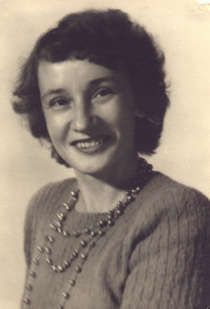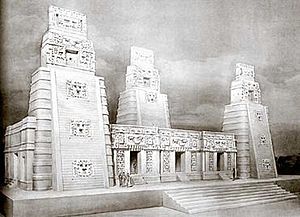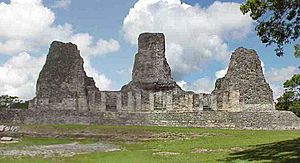Tatiana Proskouriakoff facts for kids
Quick facts for kids
Tatiana Proskouriakoff
|
|
|---|---|
| Татья́на Авени́ровна Проскуряко́ва (Tat'yana Avenirovna Proskuriakova) | |
 |
|
| Born | January 23, 1909 Tomsk, Tomsk Governorate, Russian Empire
|
| Died | August 30, 1985 (aged 76) Cambridge, Massachusetts, United States
|
| Nationality | Russian |
| Citizenship | United States |
| Alma mater | Pennsylvania State University |
| Known for | Seminal contributions to Mayanist archaeology |
| Scientific career | |
| Fields | Mayanist archaeology and linguistics |
| Institutions | Peabody Museum of Archaeology and Ethnology Carnegie Institution of Washington University of Pennsylvania Museum |
Tat'yana Avenirovna Proskuriakova (born January 23, 1909 – died August 30, 1985) was a Russian-American scholar. She was an archaeologist who made huge contributions to understanding Maya hieroglyphs. These hieroglyphs were the writing system of the ancient Maya people in Mesoamerica.
Tatiana was born in Tomsk, Russia. Her family moved to the USA in 1916. She became an American citizen in 1924. She studied architecture and graduated in 1930. Later, she joined archaeological trips to places like Piedras Negras in Guatemala. She also visited Copán and Chichen Itza.
From 1940 to 1958, she worked at the Carnegie Institute. There, she found ways to figure out the age of ancient Maya buildings. She did this by looking at their art style. She also worked at the Mayapan excavations. In 1958, she moved to the Peabody Museum of Archaeology and Ethnology at Harvard University. She worked there until she retired in 1977.
Tatiana Proskouriakoff's most important work was proving that Maya monuments recorded real historical events. She published her findings starting in 1960. Her work helped others understand Maya historical texts. It also helped piece together the political history of Maya city-states. She was honored with several awards for her amazing work.
Contents
Early Life and Education
Tatiana was born in Tomsk, Russia. Her father was a chemist and her mother was a doctor. In 1915, her family traveled to the United States. Her father was asked by the Russian leader, Tsar Nicholas II, to help make weapons for World War I.
The Russian Revolution happened, so her family had to stay in the U.S. Tatiana only visited Russia once after that. She went to meet another Maya expert, Yuri Knorozov.
Tatiana loved art, architecture, and hieroglyphs. She could read very well by age 3. She was also a talented artist and took art lessons. Her family lived in Ohio for a while. Then they moved to Lansdowne, Pennsylvania. Tatiana was the top student in her class and edited the school yearbook.
In 1926, Tatiana started studying architecture at Pennsylvania State College. She was the only girl in her class when she graduated in 1930. Even though she trained as an architect, she later worked on Maya sites. She joined an excavation at Piedras Negras in 1936–37. This site is between Mexico and Guatemala.
Tatiana's first job at Piedras Negras was to draw the ancient buildings. These trips made her passionate about studying the ancient Maya. When she returned to Philadelphia, she drew a reconstruction of the Piedras Negras acropolis. This drawing showed how the ruined buildings once looked. It was so good that it caught the eye of Sylvanus Morley. He saw her amazing talent and this led to her working with him.
Her Amazing Discoveries
While studying at the University of Pennsylvania, Tatiana volunteered to draw archaeological pictures. Her work led to an invitation to join the excavation at Piedras Negras in 1936.
Even though she didn't get a degree in Maya studies, her hard work earned her jobs. She worked at the Carnegie Institution in Washington D.C. and later at Harvard University. Sylvanus Morley was so impressed by her drawings that he helped her get a job at the Carnegie Institution. He even raised money for her to travel to Copán and Yucatán in 1939. After she finished her drawings, she became a research associate there in the early 1940s.

Tatiana soon became very interested in Maya hieroglyphs. She made big steps in understanding the Maya writing system. For example, in 1942, she studied hieroglyphs at the Takalik Abaj ruins in Guatemala. She proved that the site was partly Maya, which settled a big debate at the time.
Her greatest achievement was a breakthrough in deciphering Maya hieroglyphs. This happened in the late 1950s and early 1960s. She was studying how Maya sculpture styles changed over time. She found that the dates on the large stone monuments (called stelae) were not just religious dates. They were historical dates! They showed the birth, rule, and death dates of Maya leaders.
By looking at the patterns of dates and hieroglyphs, she showed that seven rulers had ruled over 200 years. Knowing this helped other experts, called epigraphers, finally understand what the hieroglyphs meant.
She became an honorary curator of Maya art at the Peabody Museum of Archaeology and Ethnology in 1958. Tatiana Proskouriakoff passed away on August 30, 1985, at age 76. In 1998, some of her ashes were buried at Piedras Negras. This was the same place she drew in her famous reconstructions, which helped start her career.
Awards and Recognition
Tatiana Proskouriakoff received many honors for her important work:
- Alfred V. Kidder Medal for excellence in American archaeology, 1962
- Woman of the Year by Penn State, 1971
- Order of the Quetzal, Guatemala's highest honor, 1980
- Honorary Doctorate of Laws from Tulane University, 1977
- Elected to the American Philosophical Society, 1983
Published Works
Tatiana Proskouriakoff wrote many books and articles, including:
- An Album of Maya Architecture, 1946
- A Study of Classic Maya Sculpture, 1950
- Historical Implications of a Pattern of Dates at Piedras Negras, Guatemala, 1960
- Maya History, 1993 (published after she passed away)
Images for kids
See also

- In Spanish: Tatiana Proskouriakoff para niños



